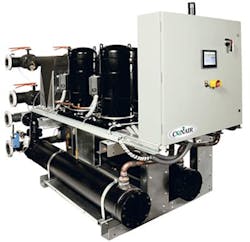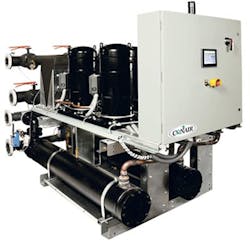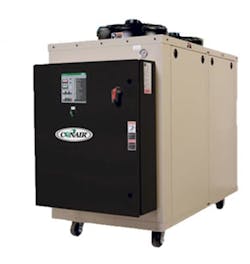Temperature Control: Central, portable chillers gaining in efficiency
The latest chillers — portable, central and adiabatic tower — incorporate variable-speed motors and drives and enhanced controls that improve operating precision while reducing energy consumption.
CONAIR UPDATES UNITS WITH ADVANCED CONTROLS, VARIABLE-SPEED CAPABILITY
Conair introduced its EP2 series of portable chillers with a variable-speed compressor option for models with cooling capacity of 10 tons or 20 tons. The variable-speed compressor, available for both water-cooled and air-cooled models, more efficiently handles partial and full chilling loads while delivering energy savings that ranges from 20 percent to 50 percent compared to fixed-speed compressors, said Tim Miller, heat-transfer product manager at Conair.
Processors can use the same 10-ton EP2 series chiller to handle any load from 3 tons to 10 tons; the larger EP2 model's range extends to 20 tons. "It is like being able to roll out a different, properly-sized chiller every time the chiller cooling load changes," Miller said.
Conair said a 10-ton chiller with a fixed-speed compressor and hot-gas bypass uses 88 percent of full-load power when running at just 30 percent of load, while a 10-ton EP2 series chiller with the variable-speed compressor option uses 36 percent of full-load power at 30 percent load.
The EP2 series features an advanced PLC-based control. The control monitors cooling load and adjusts compressor speed for optimal efficiency. It features enhanced diagnostics and can display more than 150 parameters.
Conair has also expanded its EarthSmart ESE series of central chillers. The line, introduced in 2015 with 18 models offering cooling capacities from 10 tons to 160 tons, now has chillers with up to 240 tons of cooling capacity.
EarthSmart ESE units that offer 10 tons to 80 tons of capacity have a single refrigeration circuit, while larger-capacity chillers in the line have dual-refrigeration circuits. Each refrigeration circuit has two Copeland Scroll compressors, which allow the chiller to run even if one of the compressors requires maintenance.
Each ESE chiller has its own PLC with an LCD touch screen. The easy-to-understand interface allows for quick monitoring and control. Readings provided by a common manifold-mounted temperature sensor avoid the blending and temperature drift that can occur when sensors on the supply and return lines are used, Conair said. Electronic expansion valves, rather than pressure-actuated valves, are used to compensate automatically for load variations and ambient conditions. The controller displays temperature and pressure, and provides trending screens and diagnostic tools for fine-tuning the performance of the unit.
Separate units can be connected to a single centralized control interface using twisted pair wiring. As many as six modules of varying sizes can be managed with a centralized controller, so, with the new larger-capacity units, a total cooling capacity up to 1,440 tons is possible, with up to 12 12 refrigeration circuits.
Each model comes configured either with an integrated pump and fluid reservoir or as a stand-alone unit that can supply a separate pump tank system. The ESE chillers can be water-cooled using tower water, or air-cooled.
Conair also improved the controls for its EarthSmart ESTW line of adiabatic tower chillers to better conserve electricity and water. The upgraded adiabatic tower chillers eliminate the constant water consumption and treatment requirements of conventional evaporative towers, utilizing a closed-loop approach that isolates process water from contamination, then cycling the process water through finned heat coils, where ambient air absorbs process heat and cools it for recirculation. Water consumption can be reduced up to 80 percent when compared to conventional evaporative tower systems, according to Conair. The adiabatic tower features variable-speed, electrically commutated fans and circulating motors.
During periods when ambient air is warm and maximum cooling capacity is needed, the adiabatic towers use top-mounted fans to draw warm air through wetted adiabatic panels located in front of finned heat coils. As air passes through the panels, the water within them evaporates, pulling latent heat energy from the passing air.
The control precisely matches cooling-load requirements by adjusting the fan motor speed, controlling the release of adiabatic cooling water and regulating the speed of process coolant flow. It can operate in a mode that saves water by relying on increased airflow to achieve a desired process cooling set point. It also can run in an energy-saving mode in which adiabatic cooling is activated as soon as power consumption reaches a user-defined set point.
Conair offers the ESTW series of EarthSmart adiabatic tower chillers in 11 models with cooling capacities from 17 tons to 195 tons. They handle coolant rates from 45 gallons per minute to 510 gallons per minute.
ECOCHILLERS LINE INCORPORATES SOLAR PANELS AND VARIABLE-SPEED COMPRESSORS
EcoChillers upgraded its Inverter line of central chillers to incorporate variable-speed compressors and solar panels, said Pedro Machain, process engineering manager.
The line now features Copeland Scroll ZPV variable-speed compressors for high efficiency. Meanwhile, solar panels installed in the unit deliver up to 300 kilowatts of energy.
Other features include a state-of-the-art brushless permanent magnet motor matched to a highly efficient Emerson inverter drive. The chiller also has a Swep brazed-plate heat exchanger, Alcoil Micro-Channel aluminum condenser coil, Carel controller and electronic valve technology.
DELTA T SYSTEMS ADDS PORTABLE CHILLER LINE WITH VARIABLE-SPEED COMPRESSOR
Delta T Systems, a supplier of portable air- and water-cooled chillers and temperature-control equipment, has developed a new line of high-efficiency chillers with variable-speed compressors.
The VS series, available since July, integrates variable-speed compressor technology commonly employed in residential and commercial refrigeration applications so that the chillers use only the power they need, President Jochen Naujokat said.
Adjusting the speed of the compressor allows it to run efficiently when it is operating anywhere in the range of 10 percent to 100 percent of rated capacity. As a result, a chiller with 10 tons of capacity operates as efficiently as a chiller with 1 ton of capacity. The unit also incorporates variable-speed condenser fans that have on-board sensors that continually monitor the refrigeration system to ensure efficient operation.
The ability to vary the speed yields energy savings up to 50 percent compared to conventional chillers using a fixed-speed compressor that operates at its designed load regardless of the process needs, Naujokat said. The variable-speed compressor design is also more efficient than a chiller with an advanced hot-gas bypass design. In that design, the chiller continues to run even when no cooling load is needed.
Other features of the VS chiller line include an adaptive-control function that adjusts the compressor to prevent a shutdown if an alarm condition is imminent.
The unit uses multiple large brazed-plate evaporators, made from stainless steel and copper, that perform as a heat exchanger and provide a larger evaporative surface than competing models. The larger evaporative surface reduces the demand of the compressor, making the evaporator more efficient, lowering energy costs.
The controls are designed to regulate temperature to within 0.5 degree Fahrenheit. The control collects data through digital sensors placed on the unit. An LCD shows in and out temperatures of the chiller, pump pressure, tank level, refrigerant pressures and temperatures, and alarms. It also indicates the status of the compressor, valves, pump and fan, as well as chiller capacity and power usage.
Delta T Systems offers the VS chiller in seven models with 1 ton to 15 tons of cooling capacity. Air-cooled models with 20 tons and 30 tons of capacity are available starting this month, Naujokat said.
MOKON EXPANDS SERIES OF PORTABLE CHILLERS
Mokon recently has developed different controller packages for its portable chiller systems for customers seeking improved communication and control of the process loops. The packages will offer increased controller and communication flexibility and integration.
Mokon also has updated its central chiller system's control to reduce the risk of freeze-up when there's a system shutdown during operation, said Rob Kennery, VP of sales and marketing. This change allows the pumps to run for a set time after the compressors shut down. It also allows the central chiller system to be powered down in progressive steps, he said.
Mokon has modified the controller program so that it can oversee either a two-compressor or a four-compressor arrangement, while allowing the safety protocols to protect all four of the chiller's compressors rather than just the main two, Kennery said. This allows for more efficient operation without a compromise in safety. In addition, the hot-gas bypass control circuitry has been modified to more efficiently sequence the stage-up and stage-down operations of the compressor.
Mokon's central chiller systems come in models that deliver 30 tons to 120 tons of chilling capacity and supply process fluid control down to 20 degrees Fahrenheit.
Mokon also recently expanded its Iceman SC series of portable chillers with new models that offer a lower range of operating temperatures.
The new ASL and WSL chillers are available in five models with 1.5 tons to 7.5 tons of cooling capacity that operate in a temperature range of 5 degrees to 30 degrees Fahrenheit. The ASL line uses air-cooled condensing, while the WSL models incorporate water-cooled condensing. Other models in the Iceman SC series lines provide 0.5 ton to 40 tons of cooling capacity and fluid temperatures ranging from 20 to 65 degrees Fahrenheit, Kennery said.
The ASL and WSL chillers, launched in May, feature a scroll compressor and brazed-plate evaporator, a stainless-steel centrifugal supply pump and a heavy-duty insulated plastic tank with a sight glass. A microprocessor-based controller manages all functions.
Mikell Knights, senior staff reporter
For more information
Conair Group,Cranberry Township, 724-584-5500, www.conairgroup.com
Delta T Systems,Richfield, Wis., 262-628-0331, www.deltatsys.com
EcoChillers Inc.,Austin, Texas, 713-589-3183, www.ecochillers.com
Mokon Inc.,Buffalo, N.Y., 716-876-9951, www.mokon.com





